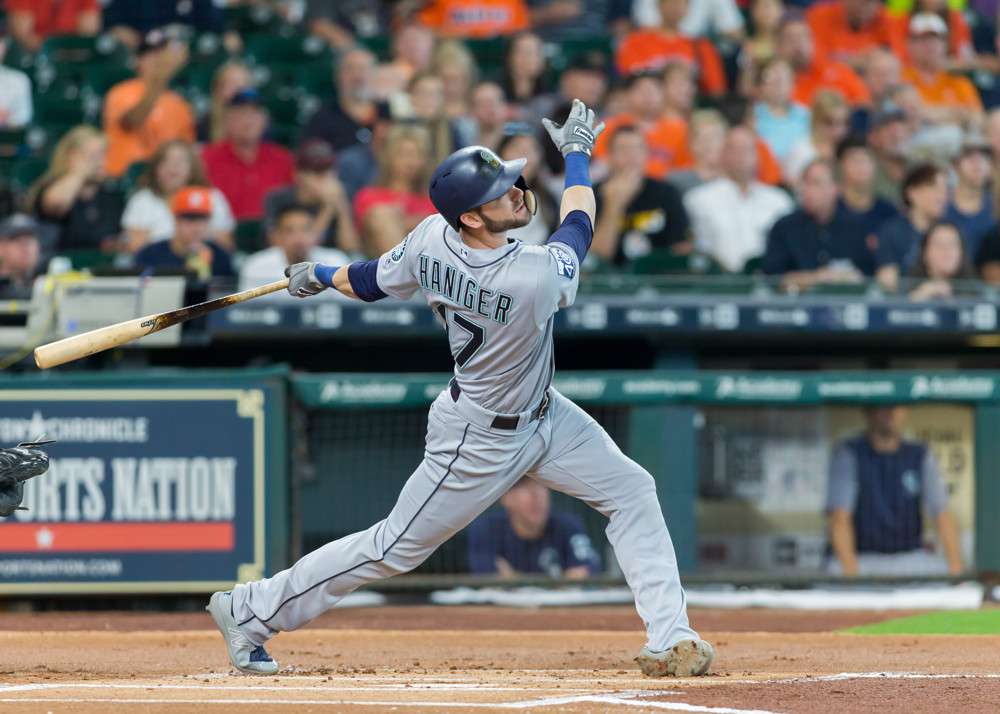
With a couple of weeks of the season now in the books, some early-season performances can start to become meaningful predictors for the rest of a player’s season. While we have not quite hit the stabilization point for most batted-ball statistics, trends are beginning to emerge which may be predictive of the player’s future results. Today, we highlight three mid-20s players with varying levels of certainty regarding their early-season performances.
Mitch Haniger, Seattle Mariners
Haniger entered the season projected as a league-average hitter. Fangraphs’ Depth Charts forecasted a .252/.322/.439 line with 22 home runs — a serviceable-enough option. His first few weeks, though, have been stellar. Haniger currently sports a .307/.382/.682 line with nine homers through 25 games.
The story is a familiar one. Haniger had always possessed above-average raw power, but this season he is hitting the ball in the air significantly more. Haniger’s fly ball rate is up 11 percentage points from last season, and his average launch angle has taken off as well. The general drawback of such an approach is that the hitter often sacrifices some contact in favor of that loft. Haniger’s contact rate has indeed fallen this season, but not as significantly as one might expect. His contact rate has dropped only four percentage points, a worthy tradeoff for his increased power output. Nor is Haniger’s success just about launch angle; he’s hitting the ball harder, too. He ranks 26th in rate of batted balls hit above 95 MPH, between Miguel Andujar and Mookie Betts, and his average exit velocity is up nearly five MPH from last season.
Even the projections, which are inherently conservative and reluctant to buy into small-sample performances, have moved considerably. Depth Charts now projects Haniger to hit 23 home runs from May onward, just weeks after projecting him to hit 22 all season. Pitchers will adjust, of course, and Haniger will not continue to hit at this rate, but he shows all the signs of a mid-20s breakout player. He is owned in nearly all leagues at this point (in those few where he remains on the wire, grab him now), but he is not a prototypical sell-high. Haniger’s underlying numbers all point to him being a different, more dangerous hitter, a tremendous value for his draft position.
Eduardo Rodriguez, Boston Red Sox
Rodriguez has quietly improved his swinging strike rate every season of his career, and he has continued that trend so far. He ranks 11th by that metric among pitchers with at least 20 innings, inducing whiffs on 14.3% of his pitches. This has been the result of Rodriguez inducing more whiffs on pitches in the zone, which can serve as a proxy for the sheer dominance of a pitcher’s stuff. While far from perfect in a small sample (Caleb Smith currently ranks in zone-contact rate allowed), it lines up pretty well with a pitcher’s overall results, and Rodriguez ranks in the top 20 thus far.
His raw stuff isn’t too different than it was in prior years, but a process change may be a factor. He continues to average around 93 MPH with mediocre spin on his fastball, but his heatmaps indicate that he has more frequently worked at the top of the strike zone thus far. He has paired that with his elite changeup, which is dropping an extra two inches on average and which he has more frequently buried beneath the strike zone.
Rodriguez plays in a difficult division and has never had great command, so he should be deployed selectively. Even so, he has always had above-average strikeout rates, and his early-season strike zone metrics portend a bit more upside there. Toss in that he is backed by one of the league’s best offenses, and Rodriguez could offer solid value if he stays healthy.
Teoscar Hernandez, Toronto Blue Jays
Hernandez is on a tear since being recalled from Triple-A, slashing .300/.375/.620 in 56 plate appearances. Coupled with a stellar September in 2017, Hernandez is at least worth grabbing if he remains on the wire. He ranks fifth in average exit velocity (minimum 10 batted ball events), and he has a long track record of hitting for power in the minor leagues. He’s got an aggressive, low-contact approach that will result in some strikeouts along the way, but he has enough power to make the batting average tradeoff worthwhile. He’s got double-digit stolen base upside, plays in a good enough lineup to have runs and RBI opportunities, and he should hit 20-25 home runs per season. Even if he regresses to his projected average levels (between .240 and .250), he’s a viable low-end outfielder.
It’s worth noting, however, that Hernandez might not be doomed as a contact hitter. Both Baseball America and Fangraphs’ Eric Longenhagen, writing up Hernandez as a prospect entering 2017, lauded his ability to make adjustments and projected him as an average to slightly above-average contact hitter. That has yet to show up at the big-league level, and it’s fair to question whether he ever will cut down on the strikeouts. Still, at age 25, there’s a chance for a bit more development of the hit tool. Even with the strikeouts, Hernandez hits the ball hard enough to be worth owning. If he cuts the strikeouts down, as some scouts thought possible just a year ago, he has a chance to be worth even more.
